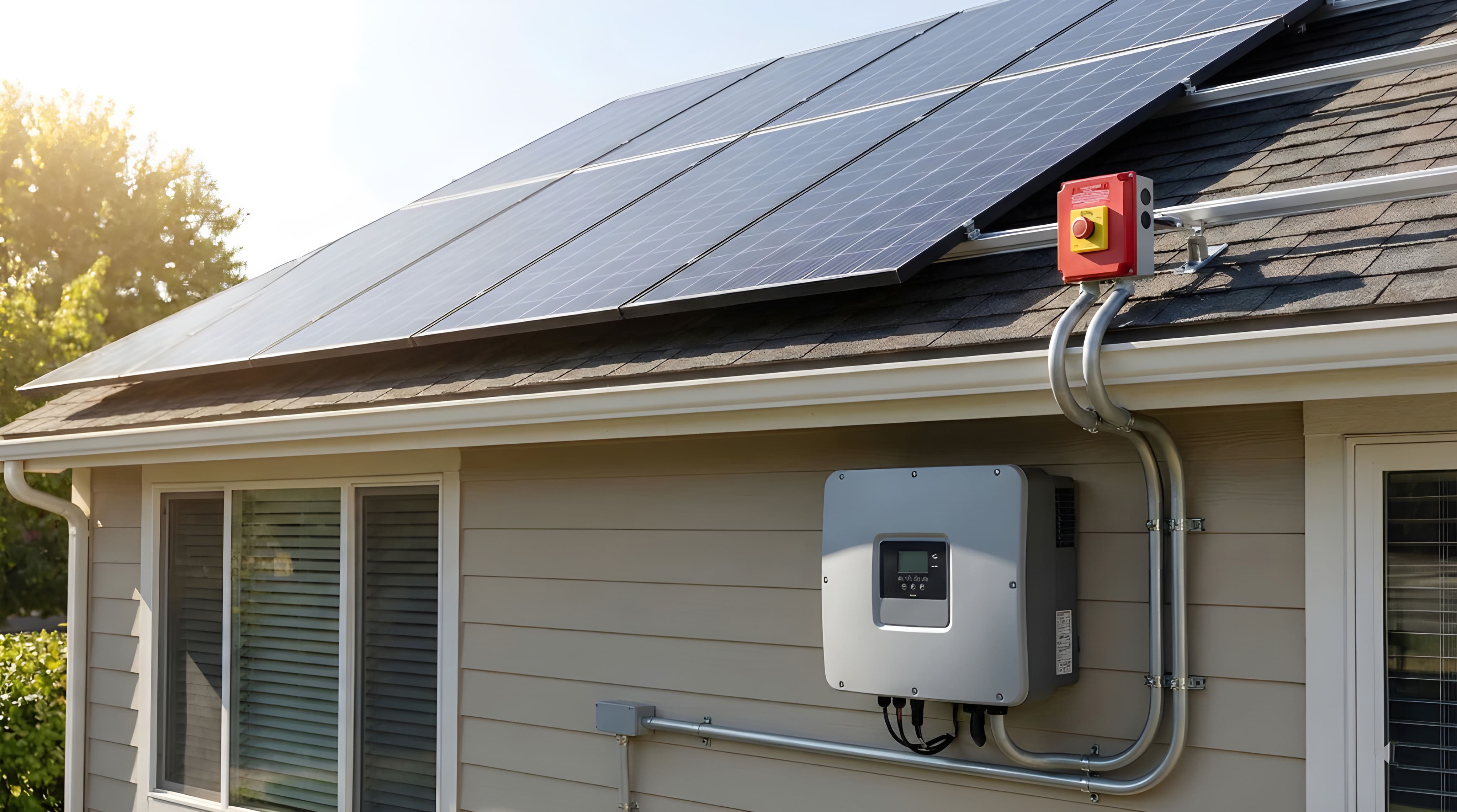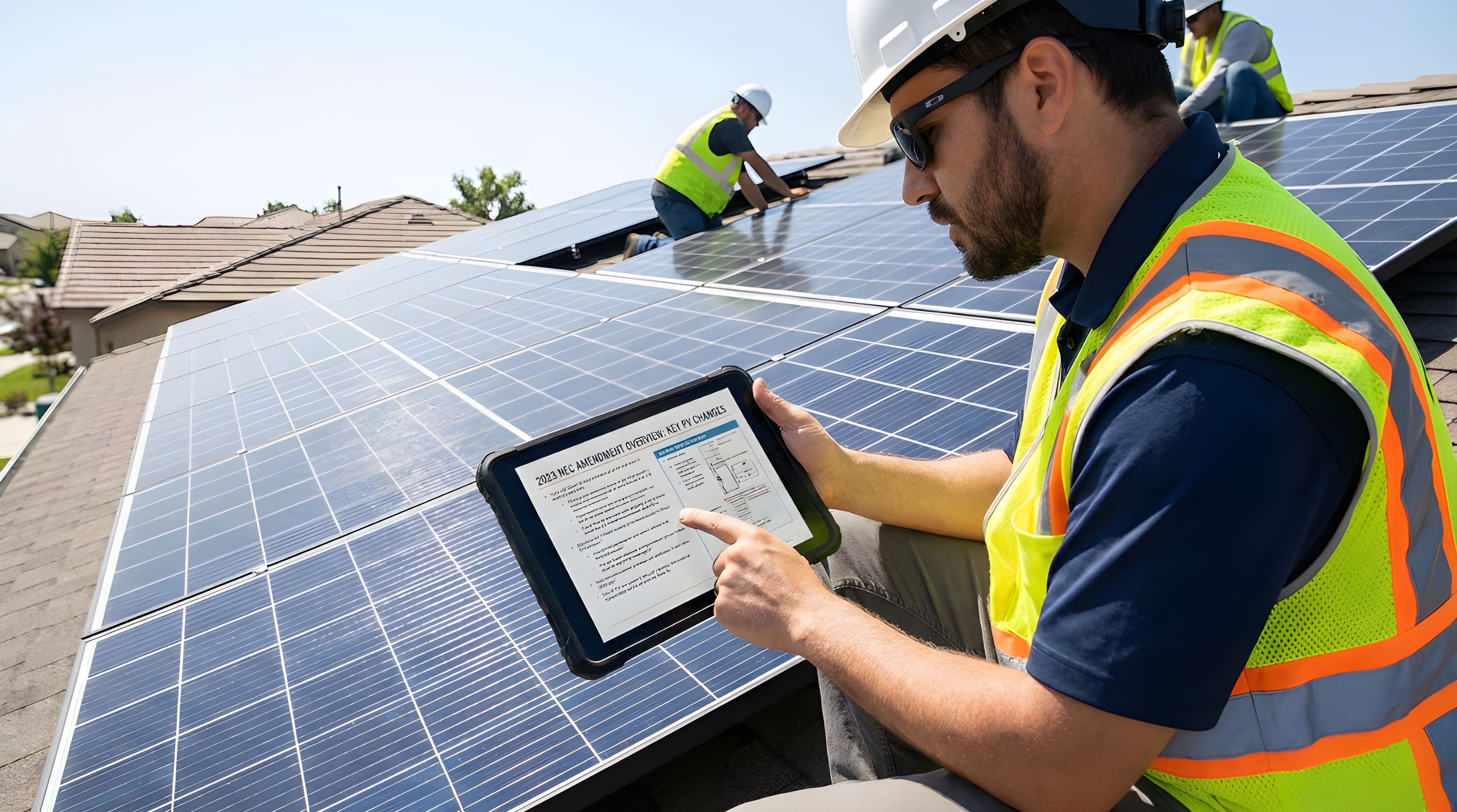

The 2023 National Electrical Code (NEC) introduced a critical exemption for rapid shutdown requirements under Section 690.12 Exception No. 2. Non-enclosed, detached structures including solar carports, canopies, parking shade structures, and trellises are now explicitly exempt from rapid shutdown device requirements.
The 2023 update clarifies that PV equipment and circuits installed on non-enclosed detached structures do not require rapid shutdown systems. This exemption applies specifically to structures where firefighters would not perform rooftop operations during emergency response.
Under 690.12 Exception No. 2, the following structures are exempt:

Rapid shutdown was originally designed to protect firefighters conducting rooftop operations on enclosed buildings. The 2023 NEC aligns requirements with actual firefighter safety needs by excluding structures with open sides where heat and smoke can escape naturally.
Current Code Status: While NEC 2026 is now published, most jurisdictions are still adopting or working under the 2023 edition. Some areas continue using the 2020 code, which did not include these clarifying exemptions. Understanding the 2023 changes remains essential for compliant solar installations nationwide.
Section 690.12 is the specific code provision that governs rapid shutdown requirements for photovoltaic systems. Understanding this section is crucial for solar designers, installers, and authorities having jurisdiction to ensure compliant installations.
The 2023 NEC version of 690.12 states:
690.12 Rapid Shutdown of PV Systems on Buildings
PV system circuits installed on or in buildings shall include a rapid shutdown function to reduce shock hazard for firefighters in accordance with 690.12(A) through (D).
Exception No. 1: Ground-mounted PV system circuits that enter buildings, of which the sole purpose is to house PV system equipment, shall not be required to comply with 690.12.
Exception No. 2: PV equipment and circuits installed on nonenclosed detached structures including but not limited to parking shade structures, carports, solar trellises, and similar structures shall not be required to comply with 690.12.
Examining the previous code cycle, the 2020 version of 690.12 specified that "PV system circuits installed on or in buildings shall include a rapid shutdown function to reduce shock hazard for firefighters in accordance with 690.12(A) through (D)." This language establishes the core objective: minimizing electrical shock risks to firefighters during emergency response operations. The requirement applies specifically to locations where firefighter activities could expose personnel to electrical hazards, particularly buildings where first responders must access roof sections containing PV modules.
The NEC Code-Making Panel received feedback from the photovoltaic industry regarding jurisdictional interpretations of the 2020 language. Many authorities having jurisdiction were applying rapid shutdown requirements to structures like solar canopies. This broad interpretation stemmed from the requirement for PV circuits installed "on or in buildings" combined with differences between the NEC's building definition and those found in building codes. Consequently, some jurisdictions adopted highly conservative approaches, mandating rapid shutdown for virtually all PV installations.

The proposal to modify the 2023 Code included detailed justification stating that PV systems requiring rapid shutdown functions should be those installed in locations where firefighters conduct rooftop operations. These locations involve enclosed spaces beneath the PV system where occupants may work, reside, or engage in similar activities. Standard firefighting protocols apply when rescuing occupants or performing vertical ventilation in such enclosed environments.
The proposal emphasized that RSD was never intended for PV systems on solar carports, accessory structures, or ground-mounted arrays. These installations allow heat, smoke, and occupants to escape through open sides. The defined scope for RSD requirements centers on enclosed spaces designed for human occupancy where activities like living, sleeping, eating, cooking, or working occur, and where proper egress routes, lighting, and ventilation exist. This code interpretation varies by state, making it essential to understand local requirements.
The Code-Making Panel approved this exclusion for certain structures, providing an accompanying statement: "New Exception No. 2 is aligned with an existing exception to requirements for firefighter roof top access and pathways in the building and fire codes."
This revision brings NEC rapid shutdown requirements into better alignment with established fire code provisions for non-enclosed structures. The 2023 update also introduced an additional clarifying exception under 690.12(A) Exception, which specifies that conductors from non-enclosed structures remaining exterior to buildings do not require RSD features. These conductors must still carry appropriate labeling according to Article 690 to warn firefighters of potential electrical hazards.
When accepting the proposal, the committee acknowledged that these installation types present inherently lower shock risks to firefighters and do not necessitate RSD systems. This clarification demonstrates that the original RSD intent excluded circuits originating from non-enclosed structures such as carports. The current code language provides clear guidance on this matter without altering installation methodologies, allowing seamless incorporation into existing projects without creating conflicts or safety issues.

Jurisdictions still operating under the 2020 NEC may hesitate to adopt the 2023 clarifications. However, authorities having jurisdiction might possess the flexibility to evaluate and implement this clarifying language without adopting the complete 2023 NEC. This approach would promote more consistent installations across different jurisdictions and reduce confusion when first responders encounter various configurations on non-enclosed, detached structures.
The 2023 updates represent an important step toward clearer, more practical rapid shutdown requirements that maintain firefighter safety while avoiding unnecessary complications for appropriate PV installation types.
The 2023 NEC updates to rapid shutdown requirements mark a significant improvement in code clarity and practical application. By explicitly exempting non-enclosed, detached structures like carports, canopies, and trellises from RSD mandates, the code now better reflects the original intent of protecting firefighters during rooftop operations on enclosed buildings. These changes eliminate previous ambiguities that led to inconsistent interpretations across jurisdictions and unnecessary implementation of rapid shutdown systems where firefighter risk was minimal.
Understanding these updates is essential for solar professionals, installers, and authorities having jurisdiction to ensure compliant and cost-effective PV installations. The alignment with existing fire code provisions creates a more cohesive regulatory framework that prioritizes genuine safety concerns without imposing excessive requirements on lower-risk installations. As more jurisdictions adopt or incorporate these clarifications, the solar industry can expect greater uniformity in requirements and reduced confusion during permitting and inspection processes.
Staying informed about NEC updates ensures that PV system designs meet current safety standards while optimizing installation efficiency and project costs.
What structures are exempt from rapid shutdown requirements under the 2023 NEC?
The 2023 NEC exempts non-enclosed, detached structures from rapid shutdown requirements under 690.12 Exception No. 2. This includes solar carports, canopies, trellises, accessory structures, and ground-mounted arrays. These structures do not require RSD systems because they lack enclosed spaces where firefighters would need to perform vertical ventilation or rescue operations, and any heat or smoke can escape through open sides.
Why were rapid shutdown requirements originally implemented in the NEC?
Rapid shutdown requirements were introduced in the 2014 NEC specifically to reduce shock hazards for firefighters responding to emergencies. The primary concern involves situations where firefighters must access rooftops of enclosed buildings to perform rescue operations or vertical ventilation. The goal is to minimize electrical risks during these critical emergency response activities.
Do conductors from non-enclosed structures require any special considerations?
Yes, while conductors from non-enclosed structures that remain exterior to buildings do not require rapid shutdown features under the 2023 NEC 690.12(A) Exception, they must still be properly labeled according to Article 690 requirements. This labeling alerts firefighters and other personnel to potential electrical hazards even when RSD systems are not mandated.
Can jurisdictions still using the 2020 NEC adopt the 2023 clarifications?
Many authorities having jurisdiction possess the flexibility to evaluate and implement specific clarifying language from the 2023 NEC without adopting the entire code update. This selective adoption can help create more uniform installations and reduce confusion while maintaining appropriate safety standards. For guidance on your specific state requirements, consult with local code enforcement teams to determine the feasibility of this approach.
What defines an enclosed space that requires rapid shutdown?
An enclosed space requiring rapid shutdown is defined as an area designed for human occupancy where activities such as living, sleeping, eating, cooking, or working occur. These spaces must have defined means of egress, lighting, and ventilation facilities. The key factor is that these are enclosed environments where firefighters would need to perform rooftop operations and where occupants could be at risk during an emergency. For assistance with permit compliance, professional solar design services can ensure your installation meets all applicable code requirements.
Need help navigating NEC requirements for your solar project? Contact our team for expert guidance on compliant solar design and permitting, or explore our latest insights on solar regulations.
We are dedicated to providing top-notch solar permit services to homeowners, business owners, DIY, and solar installers. Contact us today.